The Intel Core Ultra 7 155H Review: Meteor Lake Marks A Fresh Start To Mobile CPUs
by Gavin Bonshor on April 11, 2024 8:30 AM ESTASUS Zenbook 14 OLED UX3405MA: Graphics Performance (Arc vs Radeon)
Moving onto gaming performance, Intel has gone all out for Meteor Lake when it comes to integrated graphics by incorporating their discrete-based Arc graphics into a more power-efficient mobile package. Designed with Arc performance for mobile, Intel includes their latest Arc Xe LPG graphics cores into Meteor Lake, which includes eight Xe cores designed to provide good performance levels.
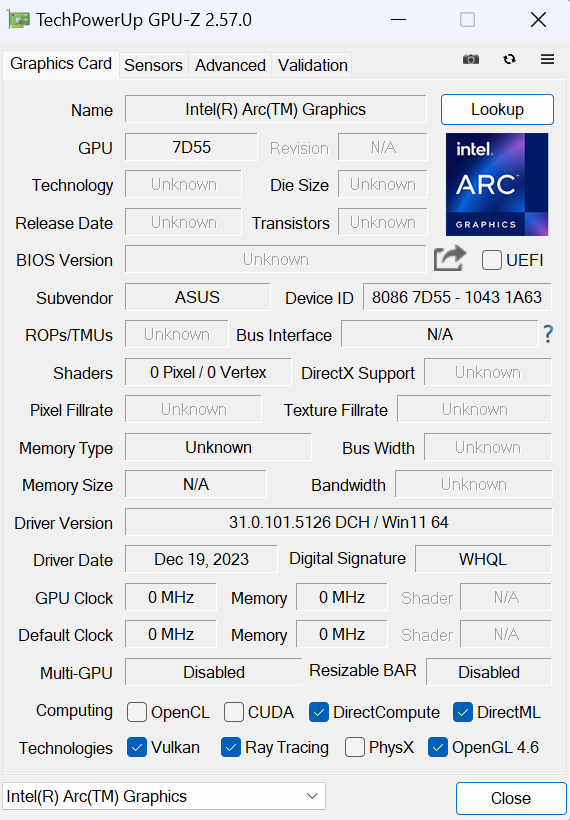
Screenshot of the Intel Core Ultra 7 155H with Arc Xe Graphics in GPU-Z
Regarding competition, AMD's mobile Radeon 780M and 760M graphics use their RNDA3 graphics architecture. The AMD Ryzen 9 7940HS and Ryzen 7 8700G both include the Radeon 780M, which includes twelve RDNA3 CUs, while the Ryzen 5 8600G uses the Radeon 760M, which is similar in design to the 780M but has just eight RDNA3 CUs. In relation to comparing both architectures, the Radeon 780M is Intel Meteor Lake's primary competition in the integrated mobile graphics arena.
Notably, here, the Ryzen 9 7940HS laptop is only using DDR5-5600 via SO-DIMMs, rather than soldered-down LPDDR5X. As a result it comes into this contest with a memory bandwidth deficit. Though by how much is uncertain, as current hardware info tools are not correctly reading the LPDDR5X memory speeds on Meteor Lake devices. Our best guess for now is that this would be paired with LPDDR5X-8533.
On the flip side, as we established with our look at power consumption, the Ryzen 9 7940HS laptop is able to sustain a much higher TDP overall – so that memory bandwidth deficit is counterbalanced by a sizable TDP advantage.
For this review, we will focus on gaming performance at 1080p, which is the most commonly used gaming resolution according to the latest Steam survey, and given these are mobile chips, we've opted for middle-of-the-road settings using the Medium preset.
Gaming Performance @ 1080p Medium Settings
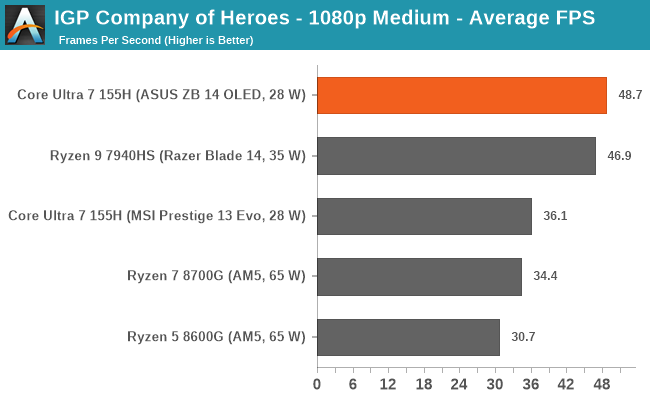
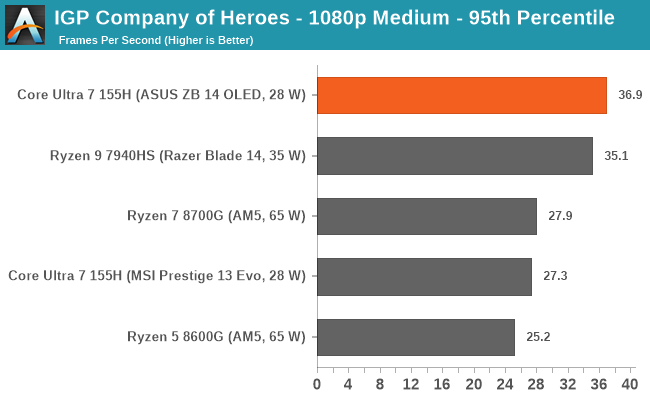
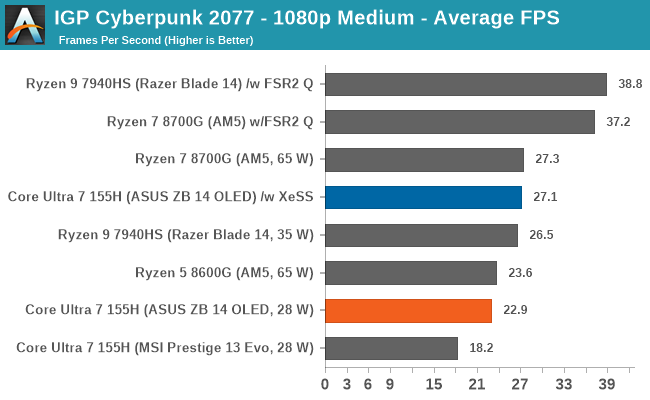
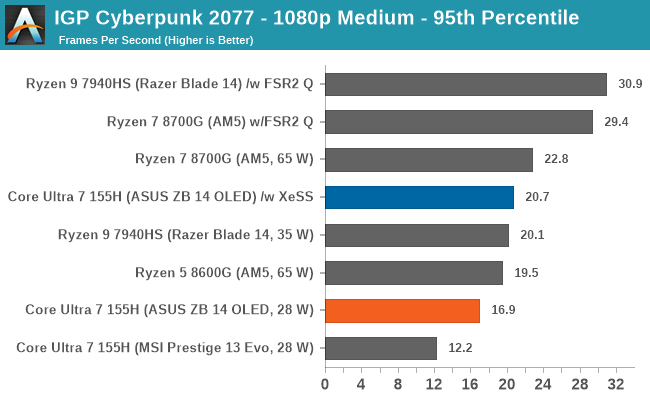
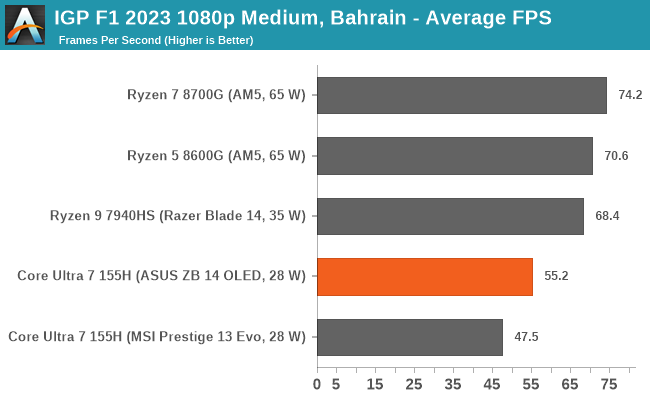
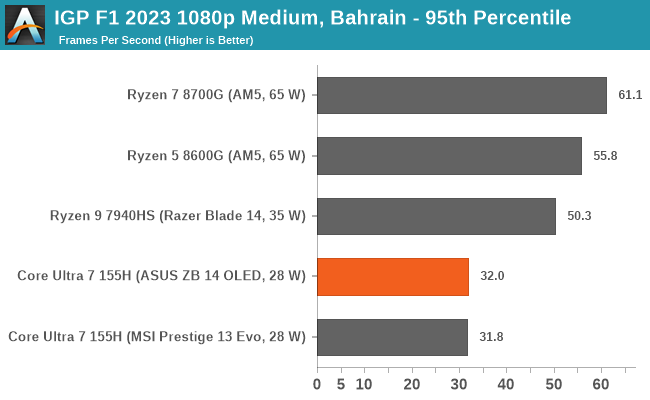
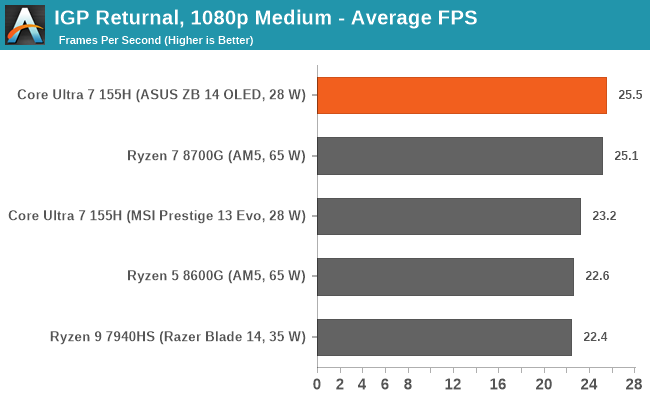

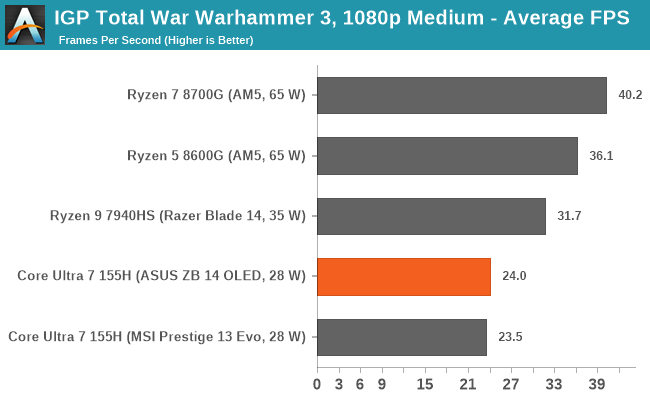

Looking at gaming performance with the 1080p resolution and medium preset across all the games, we can see that the ASUS Zenbook 14 OLED UX3405MA is very competitive with the Razer Blade 14 with the Radeon 780M chip in Company of Heroes 3. Looking at the other titles, such as Cyberpunk 2077 and F1 2023, we can see that performance lags slightly behind the integrated Arc Xe graphics when compared directly to AMD's RDNA3 architecture. The difference isn't night and day, but certainly enough to consider the Radeon 780M, the superior integrated graphics chip combined with the Zen 4 cores, even when set at 35 W.
In Returnal, Intel's Core Ultra 7 155H within the ASUS Zenbook 14 OLED performs very well, although in Total War Warhammer 3, the Meteor Lake chip displays fairly reasonable average frame rates but bottoms out massively in the 5% low framerates; this is on both the ASUS and MSI ultrabooks.
We can also see a pattern where the ASUS Zenbook 14 OLED is considerably ahead in some games than the MSI Prestige 13 Evo A1MG, despite featuring the same Core Ultra 7 155H processor. This is because the MSI notebook is actually smaller and ultimately runs with less power overall than the ASUS model. This is prevalent in our peak power testing.
Overall, there are certain benefits to Intel's Arc Xe LPG integrated graphics in Meteor Lake, and for the best part, it's competitive with the AMD Radeon 780M and 760M. We also feel that if the Intel pair of ultrabooks had better cooling, performance could be even greater, as we saw in our power analysis. That being said, Intel's Arc Xe LPG graphics work, and given that it's Intel's first go at a tiled architecture in their mobile portfolio, it provides a solid stepping stone to the next generation.










69 Comments
View All Comments
jeenam - Friday, April 12, 2024 - link
I've been an anandtech reader since 1998 or so and I'm not here to pick a bone. I'm a fan, and hope AT lives on. But did a quick search and the only two major websites with GPU reviews that referenced Returnal or Company of Heroes were Hot Hardware and Ars Technica. An expanded test suite of games might have been more appropriate because it's likely the ARC GPU would have been handily beaten across the board. Replysjkpublic@gmail.com - Thursday, April 11, 2024 - link
Strange. Some of the tests list the 155H as 28W with test results. This is misleading as the SoC uses much more power doing the test. ReplyGavin Bonshor - Friday, April 12, 2024 - link
When we review CPUs, especially when highlighting them in the charts, we list the base TDP, as every motherboard has its own interpretation of what level of power it will push through the chip (Multi-core enhancement). ReplyCarmen00 - Friday, April 12, 2024 - link
Yet in another comment, we have Ryan Smith saying "With these integrated devices, we're reviewing the notebook as much as we're reviewing the chip inside."So if you're doing what he says—post the right numbers, because that's what you're doing. And if you're NOT doing what he says, then don't post useless stuff that seems, to my (perhaps overly-critical eye) to exist so that the article can claim that Intel is scoring SOME kind of a win, when the graphs really don't seem to show a heck of a lot of CPU-related win.
I'm fine with either, let me be honest. But I want to see some consistency, that is all. Reply
Ryan Smith - Friday, April 12, 2024 - link
I'm all for trying to make sure you guys get the data that you want to see. But not sure I follow here. We are being consistent in our testing methodology, and taking care to be explicit in that our test systems don't have identical TDPs.https://images.anandtech.com/doci/21282/Core%20Ult...
In a laptop, sustained TDPs are our primary concern, as these devices cannot turbo multiple cores for more than a few seconds. So this is what we're noting in an article like this, to illustrate how we aren't testing devices with matching TDPs. Reply
ballsystemlord - Friday, April 12, 2024 - link
I agree with Ryan here, sustained performance is what you should be looking at. Anything can turbo to infinity.The only real use case for turbo, would be application start-up. But even then, you'd have to be waking the PC from idle and selecting the application in record time for it to matter at all. Reply
lmcd - Wednesday, April 17, 2024 - link
The problem I'm seeing is that this article takes the format of previous laptop reviews but not the depth (in part due to the declining access this publication), and the headline could better fit the contents. It could even be something silly like "The Intel Core Ultra 7 155H Review: Meteor Lake starts with a Moment of Zen(Book)" and be more valuable to the reader.It also did not feel like we really got (even a rehash of) an overview of Meteor Lake as a platform. So to me, this was an ASUS Zenbook review. Framing this as "ASUS ZenBook 14 OLED: A Meteor Lake Thin&Light Review" also better captures its content. Reply
eastcoast_pete - Friday, April 12, 2024 - link
I am not surprised that the Core 7 Meteor Lake isn't beating the Ryzen 7840HS in compute or graphics - that particular Ryzen 4 monolith is (IMHO) currently AMD's best foot forward, and a great APU. However, Intel did do its homework when it comes to the intended use of Meteor Lake SoCs: mobile, especially light and ultralight laptops and 2-in-1s. I don't expect a ~ 1 kg notebook to do that much higher level gaming or compute. I do expect long runtime on battery, fluid use of office and other productivity apps, and otherwise decent performance (speed). Again, AMD's Phoenix/Hawk APUs are, right now, the most performant solutions in that class, but it's good news for all of us that Intel has closed the gap. It'll mean that AMD will have to keep evolving its APUs, and maybe do a better job making them broadly available with good drivers within a few months of announcing them. Because that was not the case with Phoenix, which just took too long to be ready for prime time, and left the opening for Intel to move back into.Lastly, I find that one of the most remarkable things about Meteor Lake is that Intel got its tile design and packaging working quite well. Being able to combine different chips from different fabs (Intel and TSMC) and nodes into a cohesive unit without incurring large hits on performance and efficiency is big step forward. Reply
nandnandnand - Saturday, April 13, 2024 - link
Lunar Lake will be the one to watch. It's Meteor Lake-U evolved (4+4 instead of 2+8, on-package memory by default, decent graphics). Low power mobile chips are more interesting than the 45W+ ones. Replymode_13h - Monday, April 15, 2024 - link
> Being able to combine different chips from different fabs (Intel and TSMC)> and nodes into a cohesive unit without incurring large hits on performance
> and efficiency is big step forward.
AMD combined chiplets from both TSMC and Global Foundries in the same CPU, all the way back in Zen 2! If you count HBM, they combined chiplets from different foundries as far back as their HD Fury GPUs.
As for performance and efficiency, I find Meteor Lake underwhelming on both fronts. Idle performance and things like video playback gain a benefit from the new SoC architecture, but when it comes to compute-intensive tasks, we see why Intel kept around Raptor Lake for the performance-oriented segment. Reply